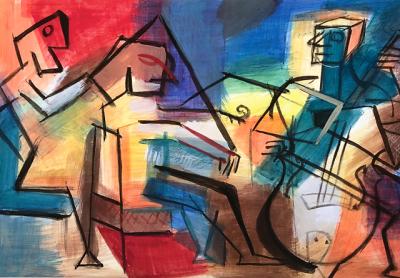‘An Intimate View’ of a Rhythmic Painter

Louis Schanker isn’t one of the first to come to mind when thinking of the grand artistic names of the mid-20th century on the South Fork, but perhaps he should be.
The painter and graphic artist’s indelible participation in the cultural community here with his wife, Libby Holman, will be featured in a talk on Saturday by Lou Siegel, the artist’s nephew, at the Pollock-Krasner House and Study Center in Springs. The former home of Lee Krasner and Jackson Pollock and current art center is the site of an exhibition of Schanker’s work from 1935 to 1943, when he was a supervisor of murals and graphic art for the Works Progress Administration. The agency, among other things, employed artists during the Great Depression so they could support themselves while doing some good for the public.
Those were the days before he found a Sag Harbor house on Madison Street in 1949, and married Holman in 1960. She was a colorful figure whose first husband died under suspicious circumstances, leaving her with quite a bit of Reynolds family tobacco money. The couple then bought a modernist house on Further Lane in East Hampton designed by Robert Rosenberg, which was subsequently destroyed, according to Helen Harrison, the director of the Pollock-Krasner House.
“I’m not sure when the Schankers bought it,” she said. “But they had it by 1962, when the famous photograph by Hans Namuth was taken. It was their annual July 4th house party, and everyone trooped down to the beach for the photo.”
Holman was a blues singer with very dark coloring, leading some people to surmise she was African-American. Witnessing oppression from both her own Jewish background and the ethnicity she was assumed to have, she became an ardent civil rights advocate. After befriending the Rev. Dr. Martin Luther King Jr. and Coretta Scott King, she encouraged them to go to India to learn Mahatma Gandhi’s peaceful resistance tactics. Coretta King also visited the couple in East Hampton, according to Ms. Harrison. As a performer, Holman “was a pioneer in introducing African-American music to a white audience,” she said.
Louis Schanker, who died in 1981, was also a music lover and used rhythm as a compositional element in his drawings, paintings, and print work. He shared this love with artists such as Stuart Davis, who was a fellow contributor to WNYC studio murals and used jazz rhythms and references in his work. Krasner, who contributed a proposal for the radio station that was never executed, became lifelong friends with Schanker, who in turn befriended her husband, another jazz enthusiast who referenced music in his work.
Included in the Pollock-Krasner House show are a few studies for Schanker’s WNYC mural, which Greta Berman, a W.P.A. scholar, sees as “a forerunner of Abstract Expressionism, in a number of ways,” she wrote in her exhibition essay. “The vague gestural figuration drawn over the colorful abstract background looks ahead to action painting. . . . And the textural surface adds to the feeling of movement.” During this time, Schanker, who was a naturalist at heart, never abandoned figuration completely, but “he can be considered in many ways an avant-garde artist,” Ms. Berman wrote.
The fact that the WNYC murals would be abstract — and all of the four contributions turned out to be, to an extent — was considered radical at the time. Burgoyne Diller, an abstract artist and director of the mural program, chose the murals because their modernity suited the modern surroundings, which boasted early examples of soundproof rooms and air-conditioning.
Schanker was also one of 10 artists who dissented in reaction to the Whitney Museum’s preference for realist artists such as George Bellows and Edward Hopper in its exhibitions. As “The Ten,” a group including Mark Rothko and Adolph Gottlieb, they staged their own abstract show in 1938.
Among the other mural studies on view in Springs are several drawings for the Neponsit Beach Children’s Hospital’s dining room, where Schanker decorated the walls in cheerful renderings of clowns and animals.
Some of the prints he worked on as a supervisor in the graphics division of the W.P.A. are here as well. There is a series of sports subjects rendered in woodblock and linoleum color prints that involved many different blocks, sometimes one for each color used. The exhibition includes examples of some of the steps in the process. Executed later than the murals, the prints continue to employ the movement he developed in those works.
There is a lot to see in such a concise show and it illuminates a period not often in evidence here. These are the last few days to see it before it closes on Saturday. The closing day gallery talk featuring Mr. Siegel is at 5 p.m. Titled “Lou and Libby: An Intimate View,” it will be an eyewitness account of the couple’s creative and social lives, including their involvement in the South Fork arts community.
This show is also the last before the Pollock-Krasner Houses reverts to its appointment-only policy, which it abandoned for the past couple of years in favor of open admissions.
